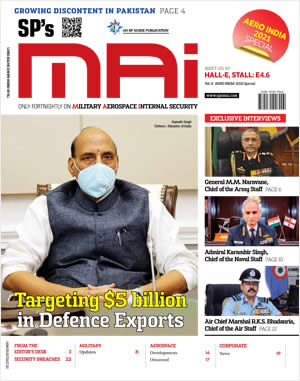INDIAN ARMED FORCES CHIEFS ON OUR RELENTLESS AND FOCUSED PUBLISHING EFFORTS

The insightful articles, inspiring narrations and analytical perspectives presented by the Editorial Team, establish an alluring connect with the reader. My compliments and best wishes to SP Guide Publications.

"Over the past 60 years, the growth of SP Guide Publications has mirrored the rising stature of Indian Navy. Its well-researched and informative magazines on Defence and Aerospace sector have served to shape an educated opinion of our military personnel, policy makers and the public alike. I wish SP's Publication team continued success, fair winds and following seas in all future endeavour!"

Since, its inception in 1964, SP Guide Publications has consistently demonstrated commitment to high-quality journalism in the aerospace and defence sectors, earning a well-deserved reputation as Asia's largest media house in this domain. I wish SP Guide Publications continued success in its pursuit of excellence.
- Appointments Committee of Cabinet approves one-month extension in service of Chief of the Army Staff
- Admiral Dinesh K. Tripathi assumes Command of the Indian Navy as 26th Chief of the Naval Staff
- Prime Minister witnesses 'Bharat Shakti' – a Tri-Services Firing and Manoeuvre Exercise in Pokhran, Rajasthan
- Interim Defence Budget 2024-25 — An Analysis
- Union Defence budget 2024
- Prime Minister Modi Commemorates Indian Navy Day in a Grand Ceremony
Land-based optronics market valued at $30 billion

Companies in the defence optronics market are set to witness growth in the future due to an increase in the number of land vehicle procurement programmes. The programmes are triggered, in turn, by the existing North Atlantic Treaty Organisation (NATO)-led operations in Afghanistan. Vehicle-mounted optronics devices will be acquired in the thousands, depending on the specific needs of local governments.
New analysis from Frost & Sullivan finds that the total market for land-based optronics will be valued at around $30.77 billion over 2010-16. This includes all soldier-mounted and vehicle-based optronics infrastructure. The research service covers Australia, France, Germany, the United Kingdom and the United States, and includes an examination of major modernisation programmes in India and parts of Europe.
“The land-based optronics market is perceived as being only marginally affected by reductions in defence spending,” notes Frost & Sullivan Programme Manager Balaji Srimoolanathan. “Although soldier hand-held and man-portable optronics devices will be procured in large numbers, the majority of revenues will be generated by vehicle-mounted/integrated optronics solutions.”
Reconnaissance, surveillance and target acquisition (RSTA) have become a critical part of armed forces’ capability to ward off any potential threat from a variety of sources. Land-based optronics solutions will enjoy precedence over air- and navybased optronics solutions in the near future due to the existing operations in Afghanistan.
“However, there will be high demand for navigation and surveillance equipment for reconnaissance and armed personnel vehicles from the emerging economies like India, Brazil, Russia, South Korea and others who are involved in huge fleet modernisation processes,” remarks Srimoolanathan.
Power needs of hand-held and man-portable optronics equipment are expected to increase tenfold in the next five years. Overcoming the power problem, therefore, will emerge as a key challenge for suppliers in this market.
A number of countries in Europe use image intensification binoculars/monoculars for surveillance. Investments in thermal imaging technology have not been significant. In the next 5-8 years, parts of Europe, Asia and the Middle East are projected to witness a shift in trend, as these countries will try to reduce the capability gap existent with their land-based C4ISTAR.
“There is a huge disconnect between the market and policy makers in emerging economies, particularly in India, countries in the Middle East and a few in eastern Europe,” cautions Srimoolanathan. “Understanding or foreseeing the need or demand of a particular nation becomes a formidable challenge for suppliers when they venture into these emerging markets. Strategic joint ventures/partnerships between two companies that complement each other in terms of products and services offered will be critical.”





